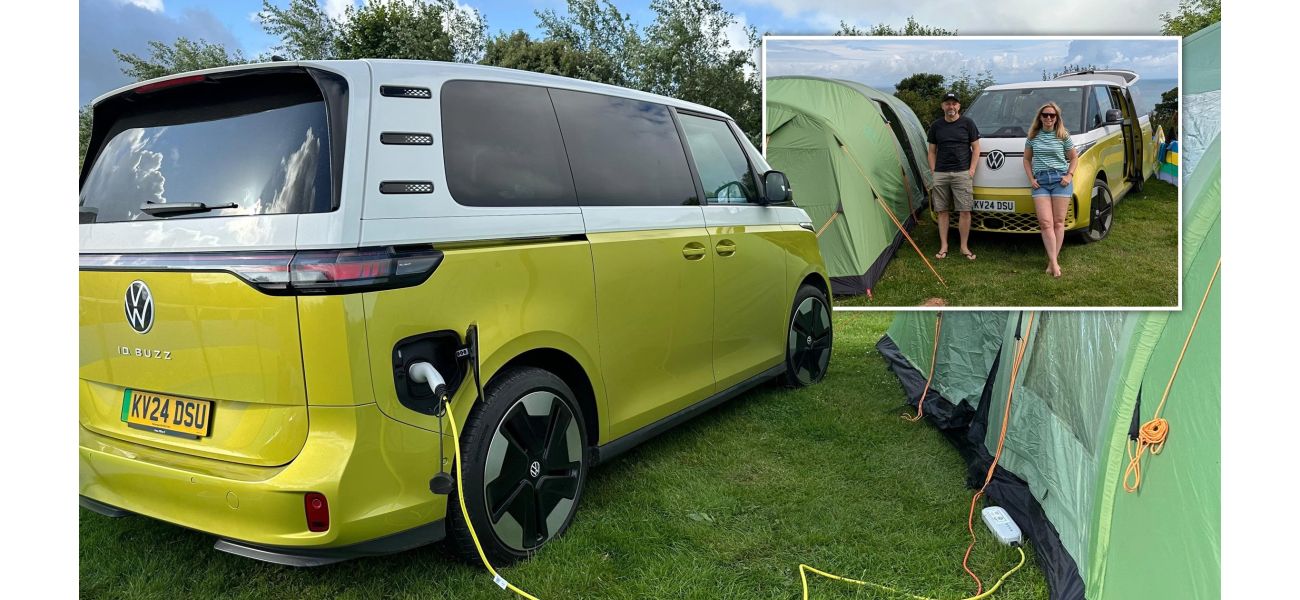I took a 500-mile road trip in an electric car and discovered the key to a nearly perfect break.
We traveled over 500 miles in four days.
September 1st 2024.

Thankfully, before embarking on our journey, I had received some valuable advice on travelling in an electric car. We were about to embark on a 500+ mile round trip in the UK, during a rather tumultuous summer, and I couldn't help but wonder what could possibly go wrong. Having previously driven a 258-mile trip in an EV to the stunning Lake District, I was well aware of the potential challenges that come with traveling long distances in a car that needs to be recharged every couple of hundred miles. However, this time, I felt more equipped and prepared for any unexpected hurdles.
After attending a female-friendly EV workshop, I received the best piece of advice that I believe I have ever received in my life. It was a simple concept, but it completely changed my perspective on traveling. The idea was to let go of the notion that your holiday only begins when you reach your destination. Instead, consider the moment you pack your last snacks and hit the start button as the true beginning of your vacation. Let's face it, it's not realistic to drive 250 miles in one go, and it's not like you can just quickly fill up your tank with £50 of petrol and be on your way. So why not embrace the journey and make the most of it?
This advice was still fresh in my mind when I was offered the opportunity to test drive VW's latest electric family vehicle, the ID. Buzz, for a few days. I was eager to see how it would perform in real-life situations. Our itinerary included a trip to the picturesque harbour town of Ilfracombe in North Devon, a destination that my husband James and 14-year-old son Jake were both excited about. Knowing that it was 258 miles away from our home, we had to plan for stops along the way. The question was, where would we stop?
After doing some research, we decided on a stop in Bristol, specifically at The Wave, a man-made surf pool with accommodation. It was 153 miles away from our starting point and we planned to spend the night in a safari tent and take a surf lesson the next day. It was the perfect pit-stop holiday plan. From there, we would continue for another 107 miles to our final destination, the Little Meadow Campsite in Ilfracombe, which had an electric hook-up for overnight charging.
We ended up covering a lot of miles on our trip and surprisingly, our electricity costs were less than £50. However, we were staying local, so we didn't need much extra juice for the ID. Buzz. Nevertheless, it was still interesting to see how much we would need.
On our way back home, instead of taking the usual route up the M5/M4/M25, we decided to make a stop in Bath. It was a 127-mile trip and we planned to have a nice meal before making the final 148-mile journey back home. Bath was the perfect pit-stop to end our trip.
Now, let's talk about expectations versus reality. As mentioned earlier, preparation was key for this trip. Thanks to the OVO chargepoint app, we were able to plan our stops meticulously. There was no room for "let's just see if there's a charger at the next service station" kind of thinking. The app, which is linked to your card details, provides locations of all its charging points across the UK, making it a valuable tool for planning. Of course, this also meant that we had to do a lot of research, but it turned out to be essential. On our first day, we decided to go off-plan and it didn't go as smoothly as we had hoped.
Although we knew we could make it to The Wave without stopping for a charge, we realized that we needed to stop for food as we had left later than expected. So we consulted the app and found a chargepoint in Boxford, which was about 60 miles away from Bristol. However, when we arrived, there was no chargepoint in sight. We searched around for a while but couldn't find it. It was a moment of panic and it made me question the accuracy of the rest of the map. However, after some further investigation, we discovered that the chargepoint we were looking for was a slow charger. So we used the app's filter to only show fast chargers and found another one just outside a pub and Co-op in nearby Newbury. We were able to grab some lunch while the car charged.
I've since learned that OVO is constantly updating their app to remove unusable charge points, so this was just an unlucky situation. I wish I could say that we encountered more problems with the EV and charge points, just to please the anti-EV crowd, but that wasn't the case.
Our main takeaway from this trip was that the infrastructure for EVs has significantly improved in the past two years. With almost 35,000 charging locations across the UK, the number of public devices has almost doubled since last year alone. If I could make a suggestion to the EV gods, it would be to have clearer motorway signs indicating the availability of charge points and which brands they belong to. This would make it easier for unplanned stops.
Now, let's talk about the car itself. With its unique lime green color and familiar design, the VW ID. Buzz is a real head-turner. It is inspired by the classic VW Transporter, which was a thing of beauty. However, thanks to its modern makeover, the ID. Buzz is more than just a cute car. We discovered this on our trip.
We had to pack our family tent and all the essentials for a two-night camping trip, along with our usual luggage for a three-night family getaway. Thanks to some clever space-saving techniques, everything fit in nicely and neatly. The sliding doors made it easy to get in and out of the car and to unload our stuff. One of the best features was the ability to fold down the back seat, creating a spacious sleeping area. This is where Jake happily slept for our two nights at the campsite, while James and I slept in the tent.
Of course, there's also the electric aspect of the car. With a fully charged battery, the ID. Buzz can travel up to 257 miles, and it can be fast charged with a maximum power of up to 170 kW. This means it can be charged from 5% to 80% in about 30 minutes.
Thankfully, I had received some great advice about driving an electric vehicle before embarking on our journey. We were about to embark on a 4-day, 500+ mile road trip in an electric car, while camping in the UK during a tempestuous summer. The thought of it made me wonder, what could possibly go wrong?
Having previously done a 258-mile trip to the beautiful Lake District in an EV, I was aware of the potential issues that may arise when traveling long distances in a car that requires charging every couple of hundred miles. However, this time I was more prepared for any potential pitfalls.
I had recently attended a female-friendly EV workshop where I received some of the best advice I've ever received: to let go of the idea that a holiday only starts once you arrive at your destination. Instead, consider the moment you pack your last snacks and press the start button as the true beginning of your break.
Let's be real, a 250-mile trip cannot be done in one go, and you can't just top up your tank with £50 of petrol and be on your way. So why fight it? With this advice ringing in my ears, I was excited for our upcoming trip where we would be taking VW's fancy electric family vehicle, the ID. Buzz, for a few days away. It would be the perfect opportunity to see how it all works in reality.
Our itinerary included a trip to the picturesque harbor of Ilfracombe in North Devon. As a big fan of the South West, my husband James and our youngest son Jake, 14, had planned this seaside adventure, which was a 258-mile trip from our home. We knew we would have to make a few stops along the way, but where exactly?
After doing some research, we decided on Bristol, specifically The Wave, a man-made surf pool and school with accommodation, which was 153 miles away. We would spend a night in a safari tent and take a surf lesson the next day. It was pit-stop holidaying at its finest. From there, we would continue on for another 107 miles to Ilfracombe, where we would stay for two nights at the Little Meadow Campsite, which had an electric hook up for overnight charging.
We covered a lot of miles on our trip, but thanks to the convenience of EV charging, our total spending on electricity was less than £50. Our final stop on the way back home was Bath, where we would take a break and enjoy a meal before making the final 148-mile trip home. Bath sounded like the perfect pit-stop on our journey back.
Expectation versus reality, preparation was key. Thanks to the OVO chargepoint app, we were able to plan every stop down to the minute. There would be no more "let's just see if there's a charger at the next service station" moments. The app, which is synced with your card details, provides the location of all its charging points across the UK, making it incredibly helpful in our planning process.
Of course, this meant we had to do a lot of homework, but it proved to be essential. On day one of our trip, we realized we needed to make an unplanned stop for food as we had left a little later than expected. We used the app to locate a charge point in Boxford, which was about 60 miles away from Bristol. However, to our dismay, when we arrived, the charge point was nowhere to be found. We drove around a few times, hoping to spot it, but had no luck. It was a bit of a setback and made me question the accuracy of the rest of the map. After further investigation, we found out that it would have been a very slow charge anyway. We decided to utilize the filter option to only include speedy charge points and found another one just outside a pub and Co-op in nearby Newbury. We were able to enjoy a nice lunch while the car charged. Later, I learned that OVO is constantly updating their app to remove unusable charge points, so it was just a stroke of bad luck. I wish I could say there were more problems with the EV and charge points, but I can't. Our main takeaway was that two years on from our first EV trip to The Lakes, the infrastructure has improved significantly. With nearly 35,000 charging locations now available across the UK, the number of public charging devices has almost doubled since last year alone.
If I could suggest one thing to the EV gods, it would be to make motorway signs clearer regarding the availability of charge points and which brands they are. This would make unplanned stops a lot easier. Overall, thanks to our amazing ID. Buzz and the beautiful scenery that surrounded us, it was a memorable and enjoyable road trip for all three of us. We were able to add in some extra stops that we wouldn't have done otherwise.
Now, let's talk about the car itself. With its dash of lime green and familiar design, the VW ID. Buzz is truly eye-catching. It is meant to be an electric equivalent of the classic VW Transporter, which was a thing of beauty. However, thanks to its 21st-century makeover, it's more than just super-cute, as we discovered on our break.
We had to pack our family tent and all the necessary camping gear for a 2-night trip, along with our usual luggage for a 3-night family trip. Thanks to the space-saving hacks, everything fit nicely and neatly into the car. The sliding doors made it easy to get in and out, as well as access our belongings. The best part was that we could fold down the back seat to create a spacious sleeping area, which Jake happily used for our two nights at the campsite while James and I slept in the tent.
Of course, the main feature of the car is its electric capabilities. With a fully charged battery, the ID. Buzz has a range of up to 257 miles, and it can be fast-charged up to 170 kW, which means it can be charged from 5% to 80% in around 30 minutes.
After attending a female-friendly EV workshop, I received the best piece of advice that I believe I have ever received in my life. It was a simple concept, but it completely changed my perspective on traveling. The idea was to let go of the notion that your holiday only begins when you reach your destination. Instead, consider the moment you pack your last snacks and hit the start button as the true beginning of your vacation. Let's face it, it's not realistic to drive 250 miles in one go, and it's not like you can just quickly fill up your tank with £50 of petrol and be on your way. So why not embrace the journey and make the most of it?
This advice was still fresh in my mind when I was offered the opportunity to test drive VW's latest electric family vehicle, the ID. Buzz, for a few days. I was eager to see how it would perform in real-life situations. Our itinerary included a trip to the picturesque harbour town of Ilfracombe in North Devon, a destination that my husband James and 14-year-old son Jake were both excited about. Knowing that it was 258 miles away from our home, we had to plan for stops along the way. The question was, where would we stop?
After doing some research, we decided on a stop in Bristol, specifically at The Wave, a man-made surf pool with accommodation. It was 153 miles away from our starting point and we planned to spend the night in a safari tent and take a surf lesson the next day. It was the perfect pit-stop holiday plan. From there, we would continue for another 107 miles to our final destination, the Little Meadow Campsite in Ilfracombe, which had an electric hook-up for overnight charging.
We ended up covering a lot of miles on our trip and surprisingly, our electricity costs were less than £50. However, we were staying local, so we didn't need much extra juice for the ID. Buzz. Nevertheless, it was still interesting to see how much we would need.
On our way back home, instead of taking the usual route up the M5/M4/M25, we decided to make a stop in Bath. It was a 127-mile trip and we planned to have a nice meal before making the final 148-mile journey back home. Bath was the perfect pit-stop to end our trip.
Now, let's talk about expectations versus reality. As mentioned earlier, preparation was key for this trip. Thanks to the OVO chargepoint app, we were able to plan our stops meticulously. There was no room for "let's just see if there's a charger at the next service station" kind of thinking. The app, which is linked to your card details, provides locations of all its charging points across the UK, making it a valuable tool for planning. Of course, this also meant that we had to do a lot of research, but it turned out to be essential. On our first day, we decided to go off-plan and it didn't go as smoothly as we had hoped.
Although we knew we could make it to The Wave without stopping for a charge, we realized that we needed to stop for food as we had left later than expected. So we consulted the app and found a chargepoint in Boxford, which was about 60 miles away from Bristol. However, when we arrived, there was no chargepoint in sight. We searched around for a while but couldn't find it. It was a moment of panic and it made me question the accuracy of the rest of the map. However, after some further investigation, we discovered that the chargepoint we were looking for was a slow charger. So we used the app's filter to only show fast chargers and found another one just outside a pub and Co-op in nearby Newbury. We were able to grab some lunch while the car charged.
I've since learned that OVO is constantly updating their app to remove unusable charge points, so this was just an unlucky situation. I wish I could say that we encountered more problems with the EV and charge points, just to please the anti-EV crowd, but that wasn't the case.
Our main takeaway from this trip was that the infrastructure for EVs has significantly improved in the past two years. With almost 35,000 charging locations across the UK, the number of public devices has almost doubled since last year alone. If I could make a suggestion to the EV gods, it would be to have clearer motorway signs indicating the availability of charge points and which brands they belong to. This would make it easier for unplanned stops.
Now, let's talk about the car itself. With its unique lime green color and familiar design, the VW ID. Buzz is a real head-turner. It is inspired by the classic VW Transporter, which was a thing of beauty. However, thanks to its modern makeover, the ID. Buzz is more than just a cute car. We discovered this on our trip.
We had to pack our family tent and all the essentials for a two-night camping trip, along with our usual luggage for a three-night family getaway. Thanks to some clever space-saving techniques, everything fit in nicely and neatly. The sliding doors made it easy to get in and out of the car and to unload our stuff. One of the best features was the ability to fold down the back seat, creating a spacious sleeping area. This is where Jake happily slept for our two nights at the campsite, while James and I slept in the tent.
Of course, there's also the electric aspect of the car. With a fully charged battery, the ID. Buzz can travel up to 257 miles, and it can be fast charged with a maximum power of up to 170 kW. This means it can be charged from 5% to 80% in about 30 minutes.
Thankfully, I had received some great advice about driving an electric vehicle before embarking on our journey. We were about to embark on a 4-day, 500+ mile road trip in an electric car, while camping in the UK during a tempestuous summer. The thought of it made me wonder, what could possibly go wrong?
Having previously done a 258-mile trip to the beautiful Lake District in an EV, I was aware of the potential issues that may arise when traveling long distances in a car that requires charging every couple of hundred miles. However, this time I was more prepared for any potential pitfalls.
I had recently attended a female-friendly EV workshop where I received some of the best advice I've ever received: to let go of the idea that a holiday only starts once you arrive at your destination. Instead, consider the moment you pack your last snacks and press the start button as the true beginning of your break.
Let's be real, a 250-mile trip cannot be done in one go, and you can't just top up your tank with £50 of petrol and be on your way. So why fight it? With this advice ringing in my ears, I was excited for our upcoming trip where we would be taking VW's fancy electric family vehicle, the ID. Buzz, for a few days away. It would be the perfect opportunity to see how it all works in reality.
Our itinerary included a trip to the picturesque harbor of Ilfracombe in North Devon. As a big fan of the South West, my husband James and our youngest son Jake, 14, had planned this seaside adventure, which was a 258-mile trip from our home. We knew we would have to make a few stops along the way, but where exactly?
After doing some research, we decided on Bristol, specifically The Wave, a man-made surf pool and school with accommodation, which was 153 miles away. We would spend a night in a safari tent and take a surf lesson the next day. It was pit-stop holidaying at its finest. From there, we would continue on for another 107 miles to Ilfracombe, where we would stay for two nights at the Little Meadow Campsite, which had an electric hook up for overnight charging.
We covered a lot of miles on our trip, but thanks to the convenience of EV charging, our total spending on electricity was less than £50. Our final stop on the way back home was Bath, where we would take a break and enjoy a meal before making the final 148-mile trip home. Bath sounded like the perfect pit-stop on our journey back.
Expectation versus reality, preparation was key. Thanks to the OVO chargepoint app, we were able to plan every stop down to the minute. There would be no more "let's just see if there's a charger at the next service station" moments. The app, which is synced with your card details, provides the location of all its charging points across the UK, making it incredibly helpful in our planning process.
Of course, this meant we had to do a lot of homework, but it proved to be essential. On day one of our trip, we realized we needed to make an unplanned stop for food as we had left a little later than expected. We used the app to locate a charge point in Boxford, which was about 60 miles away from Bristol. However, to our dismay, when we arrived, the charge point was nowhere to be found. We drove around a few times, hoping to spot it, but had no luck. It was a bit of a setback and made me question the accuracy of the rest of the map. After further investigation, we found out that it would have been a very slow charge anyway. We decided to utilize the filter option to only include speedy charge points and found another one just outside a pub and Co-op in nearby Newbury. We were able to enjoy a nice lunch while the car charged. Later, I learned that OVO is constantly updating their app to remove unusable charge points, so it was just a stroke of bad luck. I wish I could say there were more problems with the EV and charge points, but I can't. Our main takeaway was that two years on from our first EV trip to The Lakes, the infrastructure has improved significantly. With nearly 35,000 charging locations now available across the UK, the number of public charging devices has almost doubled since last year alone.
If I could suggest one thing to the EV gods, it would be to make motorway signs clearer regarding the availability of charge points and which brands they are. This would make unplanned stops a lot easier. Overall, thanks to our amazing ID. Buzz and the beautiful scenery that surrounded us, it was a memorable and enjoyable road trip for all three of us. We were able to add in some extra stops that we wouldn't have done otherwise.
Now, let's talk about the car itself. With its dash of lime green and familiar design, the VW ID. Buzz is truly eye-catching. It is meant to be an electric equivalent of the classic VW Transporter, which was a thing of beauty. However, thanks to its 21st-century makeover, it's more than just super-cute, as we discovered on our break.
We had to pack our family tent and all the necessary camping gear for a 2-night trip, along with our usual luggage for a 3-night family trip. Thanks to the space-saving hacks, everything fit nicely and neatly into the car. The sliding doors made it easy to get in and out, as well as access our belongings. The best part was that we could fold down the back seat to create a spacious sleeping area, which Jake happily used for our two nights at the campsite while James and I slept in the tent.
Of course, the main feature of the car is its electric capabilities. With a fully charged battery, the ID. Buzz has a range of up to 257 miles, and it can be fast-charged up to 170 kW, which means it can be charged from 5% to 80% in around 30 minutes.
[This article has been trending online recently and has been generated with AI. Your feed is customized.]
[Generative AI is experimental.]
0
0
Submit Comment





